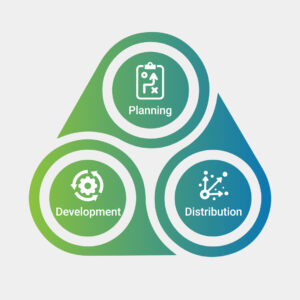The coronavirus pandemic pulled the future into the present. The last decade was already seeing a gradual increase in the number of people working remotely, but those numbers skyrocketed when the pandemic hit. Companies often had no choice but to adjust to a world where a large chunk of their workforce worked from home.
Enterprise Technology Research surveyed 1,200 CIOs from around the world in different industries and discovered that CIOs expect 34.4% of their workforce to work from home permanently in 2021, up from 16.4% before the pandemic. Most companies today have a hybrid workforce, where some employees work from home while others work from the office.
If your company has a hybrid workforce, you now have a unique challenge to deal with: how do you adjust your learning strategy so both remote and office employees have the same learning experience? This blog post will discuss three important points to help you address this challenge.
Update Your Distribution
The sudden shift to remote work is a perfect example of the importance of a continuous Learning & Development (L&D) model. The world changes too fast to have a static L&D model. You need something that can change whenever the world around you changes. A continuous model has three stages that you constantly iterate on:
- Planning
- Development
- Distribution
If you have a hybrid workforce, you need to update the distribution stage of the model. Remote workers aren’t in the office, but still need an easy and secure way to access your L&D content. Consider what that looks like for your company. Do you move all your content to the cloud? Do you give remote employees laptops with preconfigured L&D software?
How you update distribution will depend on many factors specific to your company. But you cannot leave this hanging, otherwise your remote employees will feel left behind when it comes to L&D. Updating distribution will ensure that remote employees have the possibility of career progression at your company too.
Move to Blended Learning

A hybrid workforce further encourages the idea of blended learning. It’s much harder to put all employees in a classroom or have them all go through 1:1 instructions when half your workforce is remote. You need to place a bigger emphasis on a variety of learning methods, such as online modules that deliver content through text, audio, and video.
This doesn’t mean you should entirely remove the classroom as a delivery method. It might still be a good idea to bring all employees to one location for a few days of learning. But it can no longer be the go-to method, simply because it’s much more difficult and expensive to group a hybrid workforce together.
Blended learning will make your L&D model more flexible, efficient, and cost-effective. In addition, employees prefer bite-sized modules that they can learn from at their own pace, regardless of where they’re located. Even if you don’t have a hybrid workforce, blended learning is the way forward.
Update Your Content
A hybrid workforce is a big structural change that has repercussions in many areas of a company. That’s why it’s a good idea to consider the content of your L&D model. You might need to add new courses so people can adjust to hybrid work appropriately.

For example, a course on how to give feedback remotely. It’s hard to give feedback in the first place and even harder to do so remotely. A strong course to educate people on this topic is a good idea. Another example is remote security. Tessian reported that 82% of IT leaders believe their company is at greater risk of phishing attacks when people work remotely. Create a course to educate people on this topic too.
A continuous L&D model allows you to update your content without having to drastically change your entire model. That’s the power of it. Being able to add new content and remove outdated content will keep your L&D fresh and interesting for your employees, remote or not.
To Conclude
We covered three ways you can adjust your learning strategy for a hybrid workforce: update your distribution, move to blended learning, and update your content. Depending on the specific configuration of your hybrid model, you may need to do other things too.
That’s where a company like Skill-Up Technologies comes in. We offer digital learning strategies, solutions, and services that are tailored to your requirements. Together with Skill-Up Technologies, you can adjust your learning strategy so it is ready for a hybrid workforce.



